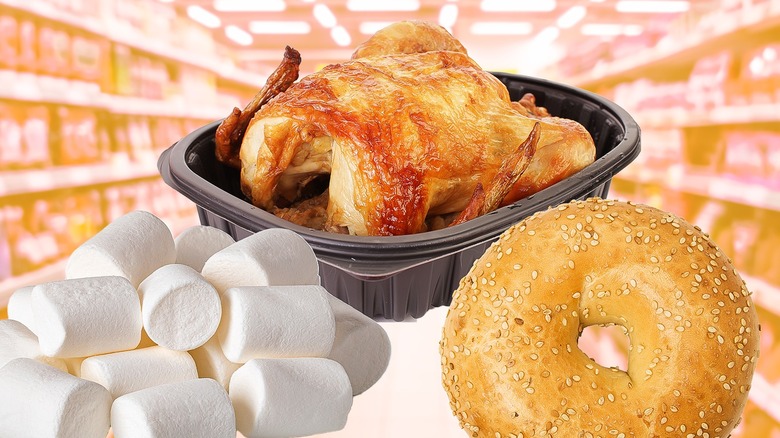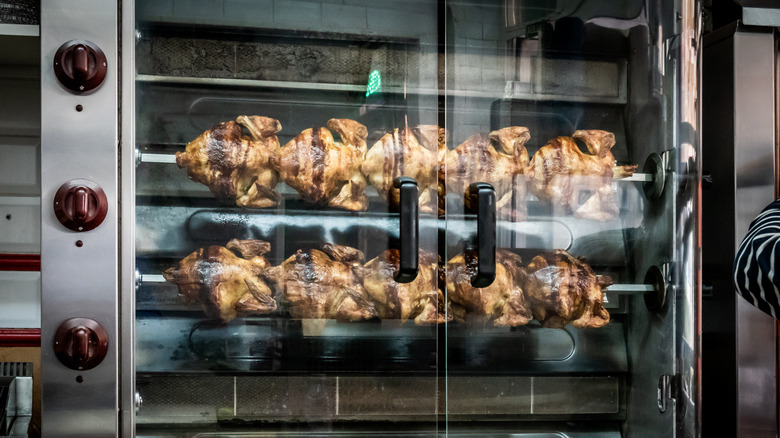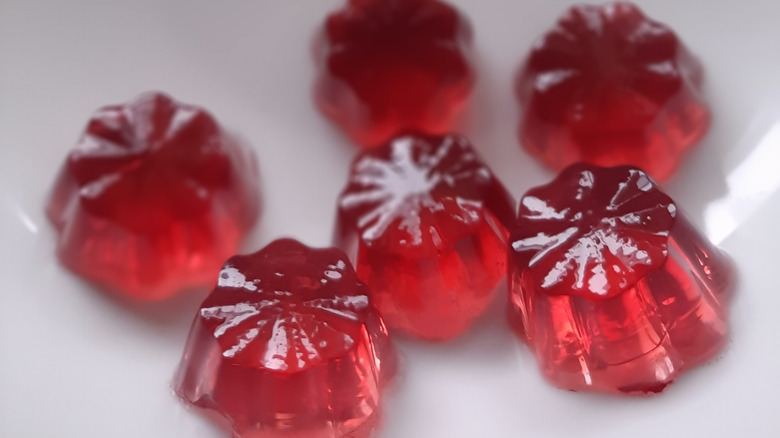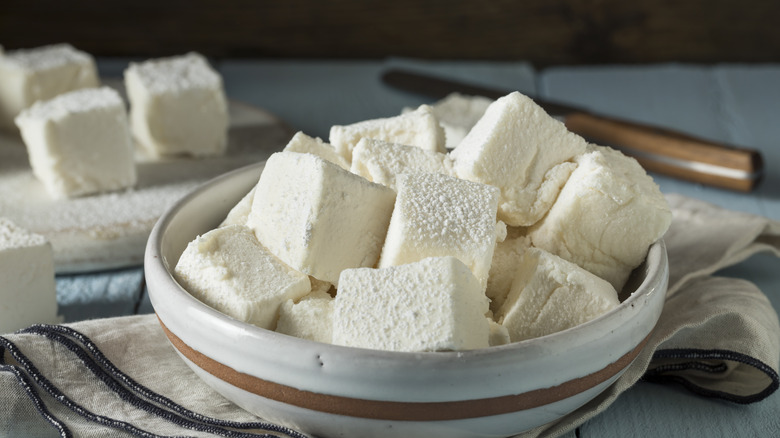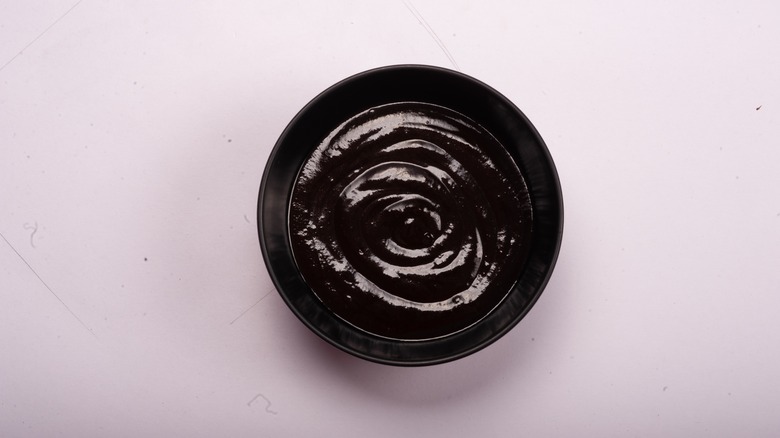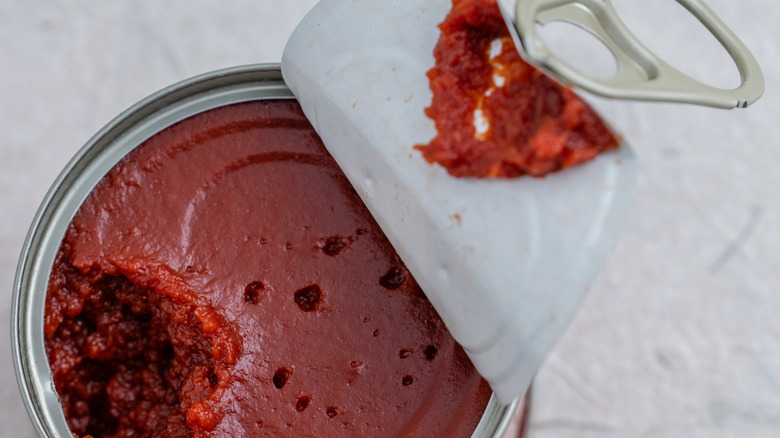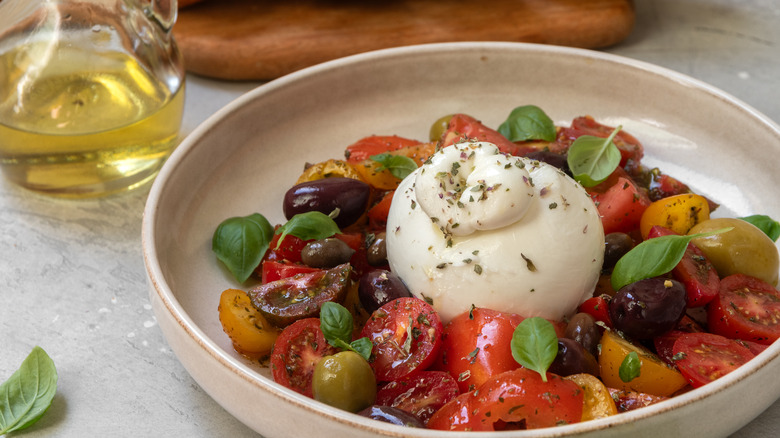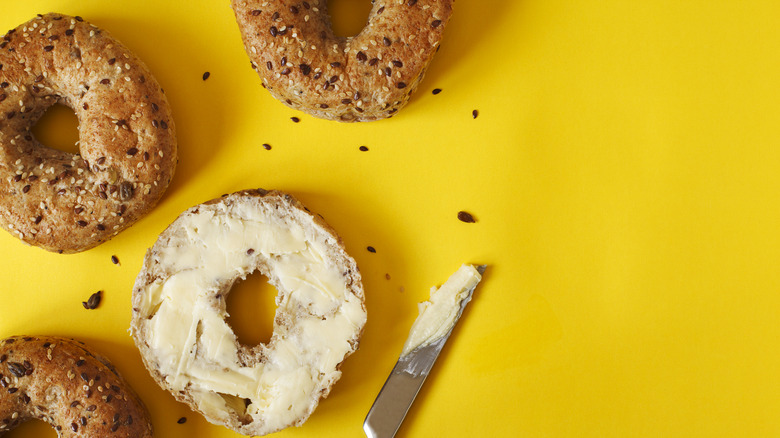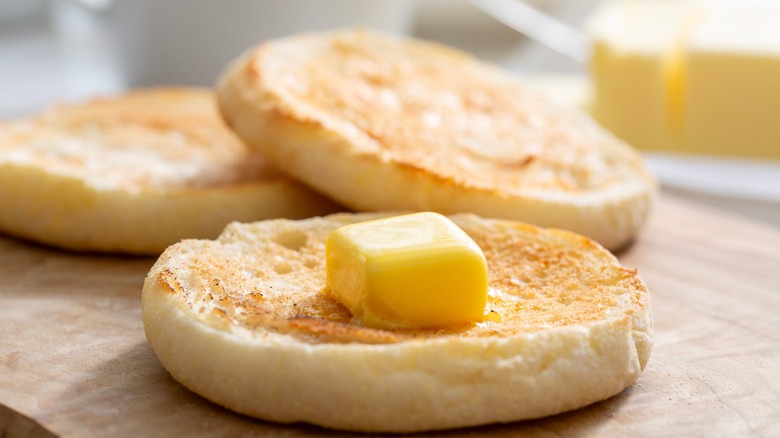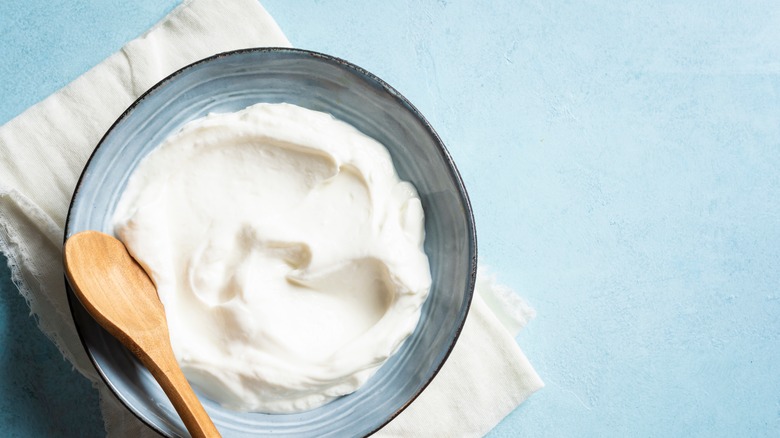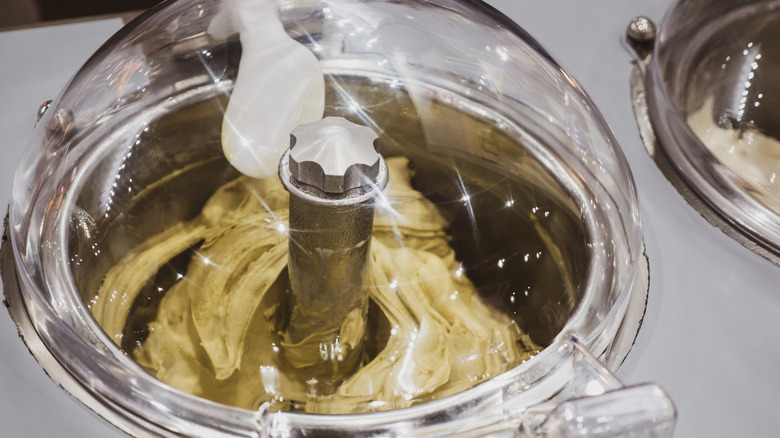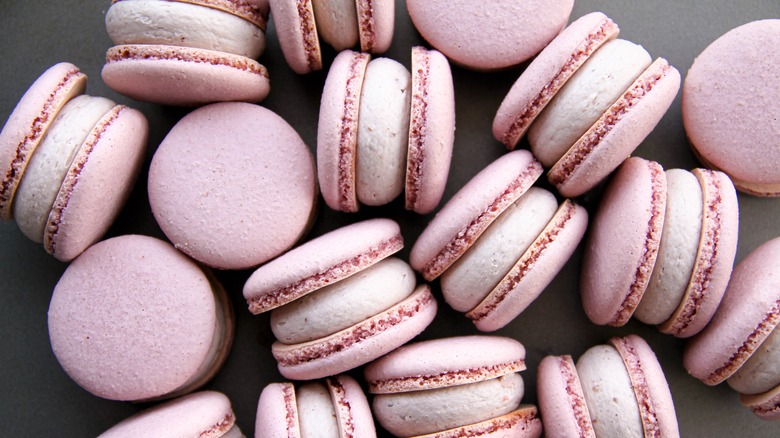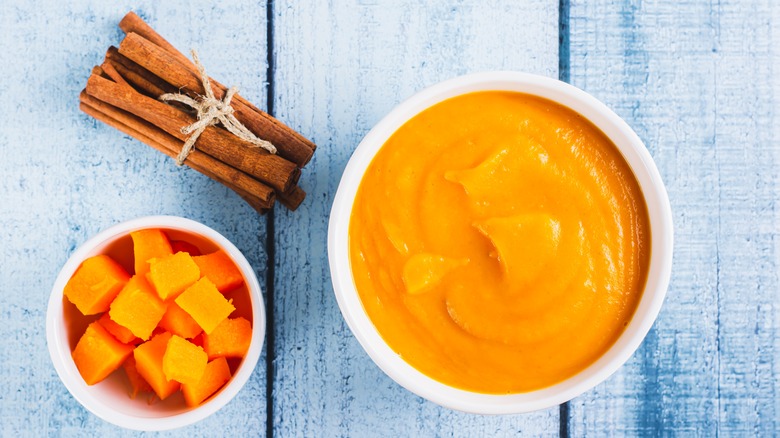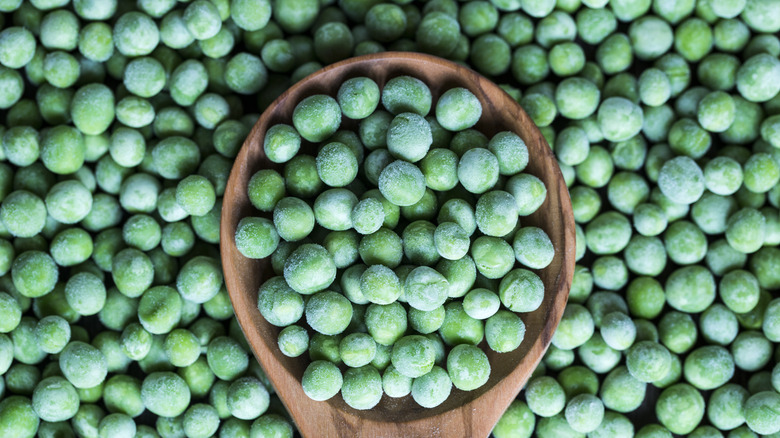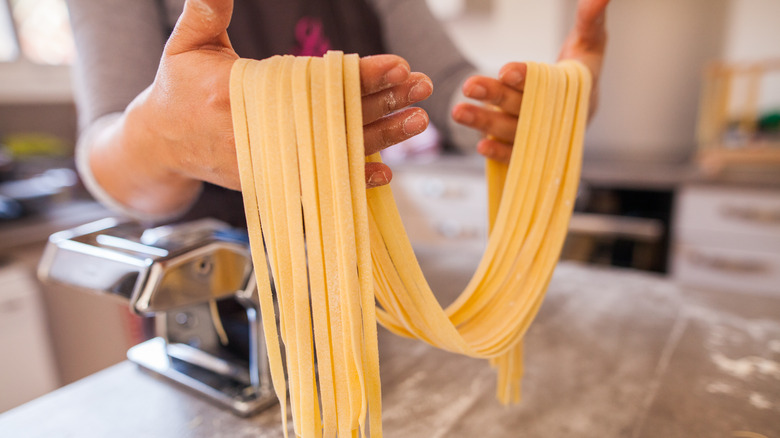18 Foods You're Better Off Buying From The Store
There is a lot of value in being able to make your favorite foods at home. After all, how satisfying is it to take a whole bunch of ingredients that you sourced yourself and turn them into something you never thought possible? It's those small victories, like finding new ways to use a certain spice or perfecting the technique for making a complex recipe, that make home cooking worth it.
In that same vein, there are some food items and recipes that make you say, "Why did I ever think this was a good idea?" As a home cook myself, I've gotten way over my head far too many times and quickly realized that I should have just listened to my gut instinct and left some recipes up to the professionals — meaning either the folks at my grocery store or other purveyors. And now, I'm here to help stop you from making the same mistakes as I did. I consulted with the founder and professional recipe developer behind A Recipe for Fun, Lindsey Neumayer, on what items you're better off buying from a store rather than making yourself at home.
1. Rotisserie chicken
I won't blame you if your mouth starts to water when you see those rotisserie chickens spinning around and around at your local deli counter. There's just something so transfixing about watching these plump birds get perfectly cooked on all sides. And considering that there are so many uses for your leftover rotisserie chicken, you might just ask, "Well, why can't I do that at home?"
The reasoning, recipe developer Lindsey Neumayer explains, is simple. "Grocery store delis have premium cooking machinery to cook rotisserie chicken perfectly, a task a lot of home ovens can't do without major add-ons or upgrades," she says. So while your local grocery store might be well-equipped to get the perfect crust on the outside of the bird, you will be stuck trying to modify your oven to cook your chicken. Of course, you could always try to poke a stick through it and roast it over a fire, but even then, your results will be wildly inconsistent from what your grocery store can offer.
2. Gummy candies
Gummy candies are the stuff of nightmares. And no, I'm not just talking about them because they got stuck in my braces constantly as a kid. Rather, they are such a pain to make at home. "While they look like a fun TikTok project, making gummy candies requires specialty ingredients like pectin, gelatin, and even citric acid, not to mention specialty supplies like molds for setting the candies," says Lindsey Neumayer. It can be a ton of investment to get the proper equipment that you need — which is really a waste, unless you make these candies frequently. Moreover, making these candies can be dangerous, as hot sugar and uncovered skin don't mix well.
Neumayer goes on to explain that getting the ideal consistency for these candies can also be difficult. So, unless you're experienced and take all the proper precautions, just buy the darn gummy Lifesavers and call it a day.
3. Marshmallows
Marshmallows might seem like a pillowy, soft, delicious treat. But they're only a treat when you buy them from the grocery store — rather than attempt to make them at home. Making marshmallows is a very messy endeavor that will require you to precisely measure your ingredients, monitor the temperature of the sugar, and more. Plus, you have to wait several hours before your marshmallow squares will be able to be enjoyed.
There are some sticklers out there who will claim that making homemade marshmallows will give you a treat that tastes a million times better than the bagged marshmallows you buy from the store. But, in reality, all of that work is not worth the result. Not to mention that marshmallows tend not to last very long. So, all of your work will be in vain when you inevitably open the bag and find that the marshmallows you spent several hours on are stale and hard.
4. Phyllo and puff pastry
Of all of the items on this list, thinking about making my own puff pastry or filo dough gives me the most profound anxiety. While mastering a pie dough is a walk in the park, making your own pastry and filo dough is like trying to climb through a fiery pit with snakes, dragons, and alligators all waiting there to greet you. Lindsey Neumayer calls these doughs "tedious" to work with and explains that there is always the risk of the butter melting out improperly from your dough and setting off smoke alarms. "I learned this the hard way in pastry school," she remarks. Luckily, you can just buy sheets of this dough from the frozen aisle of your grocery store for your strudels, galettes, and more.
If you can't make the dough, you also have no business trying to make the pastries. Baklava, which is made by assembling thin sheets of filo, nuts, and syrup atop one another, is not something that I would recommend trying at home. And leave the croissants up to the professionals, too.
5. Specialty sauces
Specialty sauces, which include soy sauce and chili sauce, can be difficult to replicate in your home kitchen. Lindsey Neumayer also shares that they may require fermentation, which will require you to purchase a ton of extra supplies and tools. "It's very time-consuming and can have a large upfront cost to get everything you need to make it," she explains.
Not to mention, the recipes you find online are often copycats of the original ones; so, it will be hard to find the perfect amount of each ingredient to add to your sauce. So, rather than play the guessing game, just go get a bottle of whatever you need from the grocery store or specialty market to whip up a tasty stir fry or dressing.
6. Tomato paste
Tomato paste is one ingredient that even I admit to taking for granted. It's so easy to scoop out a small serving from a can, or better yet, squeeze some out of a tube, into your recipe to add elements of sweetness and umami.
The main reason why tomato paste isn't really practical to make at home is because you have to use a whole lot of tomatoes for very little paste. You'll need to remove the seeds, boil the tomatoes, puree the fruits, reduce the tomato sauce, and then bake it in the oven for several hours to remove the rest of the liquid and concentrate that sugar. That's a whole day's work for a just a smidgen of tomato paste!
7. Stocks, broths, and bone broths
I'm a big fan of cutting down food waste in any and all forms. But the amount of time it takes to get a pile of chicken bones and some spare vegetables to whip up some homemade chicken stock? It's not just worth it.
"I always make sure to have a few cartons of bone broth and stock in my pantry for times when I don't have a weekend to spare making my own," says Lindsey Neumayer. This is a great strategy, as you can still freeze animal bones and vegetable scraps until you're ready to make a big batch. But when you need a little bit of broth for a soup, just crack open the box from your pantry and pour in as much of the broth or stock as you need. This backup plan will save you a ton of time in the long run and will ensure that your recipe is on the table by dinnertime.
8. Cheese
Making a bowl of homemade ricotta was one of my favorite childhood experiments. But that doesn't mean making every other type of cheese is as easy as ricotta. "... When it comes to specialty aged cheeses like Parmesan and aged gouda, it's just not possible to create the same flavors at home without a personalized cheese cave," says Lindsey Neumayer. Plus, each of these cheeses requires different steps and timelines for cutting, cooking, and aging.
Your grocery store or cheesemonger will give you a plethora of different cheeses to choose from that are nearly impossible to replicate at home. Plus, it's a one-stop shop; you can grab cheese, crackers, jam, and more to fill up your charcuterie board.
9. Bagels
I love bagels and have tried countless times (unsuccessfully, as you can probably guess) to try to recreate my favorite type of bagel at home. Bagels are different than other types of bread because they require boiling in barley malt syrup to get that distinct shine and crust. This just compounds the challenge of mastering a yeast bread dough, which can seemingly sense fear from a mile away. It's a recipe for disaster every single time, especially if you're just dipping your toes into the world of bread making.
My piece of advice is to find a solid store-bought bagel brand — or even better, go to your favorite bagel shop and buy a dozen, pop them in the freezer, and then defrost them when you get the craving for one. It's virtually no mess, and they will likely come out better than anything you can make yourself.
10. English muffins
English muffins are, by far, one of the most mysterious types of bread out there. Until I really thought about it, and researched how exactly companies made English muffins, I never realized how difficult they were to master. And now, the more that I know, I can confidently say that this is a recipe I will not be making at home any time soon — and one that I don't think you'll need to try, either.
Not only is getting the perfect yeast dough important for this recipe, but you also have to allocate for the rise; some recipes will even recommend letting the muffins sit for upwards of eight hours so that the dough can rise properly and develop that distinct yeasty flavor. Not only that, but you also have to cook the muffins in small batches on the stove to ensure that they get the perfect color on the bottom and top. It seems like a lot of effort for a food you can eat in under 10 bites and buy at the store for just a couple of dollars.
11. Yogurt
Although it might not be at the top of your list for things to try and make at home, there are some people out there that do, in fact, try to conquer a homemade yogurt recipe themselves. The milk just needs to be heated up on the stovetop before it's mixed with live cultures and left to sit — for eight to 12 hours. So much for a quick and easy breakfast.
Lindsey Neumayer even goes so far as to claim that because you have to have a "mother culture," you can never truly DIY this recipe yourself. "It can take time to figure out how to get the best consistency, too, so if you're not looking for a new hobby, it's more convenient to just buy it at the market," she says. Homemade granola? That might be a little more doable.
12. Ice cream
Making ice cream as a kid? Fun. Whimsical. Happy. Making ice cream as an adult? A whole lot more work than just plopping down on the couch with a spoon, a pint, and your favorite TV show. The issue with making ice cream is the appliance itself. Crank churns take a whole lot of manual labor, while those automatic ones will require that you freeze the vessel ahead of mixing your ice cream. So, it makes for a lot of planning ahead, and also means that you have to dig out extra space in your freezer.
You might think about just trying a no-churn ice cream recipe, but Lindsey Neumayer has her reservations. "No-churn ice cream never lasts longer than a day or so before it gets plagued by ice crystals," she says. So, patronize your favorite ice cream brand or local scoop shop for a sweet, low-effort treat.
13. Macarons
Macarons are absolutely tantalizing to look at when they're in the window of your local bakery. Their almond flour and meringue shells are so beautiful and dainty, and the squishy filling inside acts as the perfect complement to the crisp, yet still soft, shell.
But before you whip out your stand mixer and your baking mats, do your research on macarons first. Homemade macarons are one of the many foods that can seemingly sense fear. You'll need to make an Italian meringue, which doesn't hold up well when the weather is too humid. Plus, the meringue calls for you to whip up a sugar syrup, which is not an easy task for a novice or someone without attention to detail. If you look away from it for too long, it can turn into caramel or flat-out burn. Moreover, if you get past this stage, you'll need to pipe, bake, and cool your shells. That's a lot of work for two to three bites.
14. Pumpkin puree
Have you ever wondered how a sweet pumpkin turns into a can of pumpkin puree fit for your autumnal pie? If you've tried to make homemade pumpkin puree yourself, you know that the process is anything but worth it. You'll have to rid the pumpkin of its seeds before roasting, peeling, pureeing, and straining it out. Why would you put all that work in when there is a perfectly good can of pumpkin puree — which will always come out more consistent than the stuff you try to make at home — on the shelf at your grocery store?
Not to mention, you'll likely constantly second guess yourself when you make homemade pumpkin puree. You'll keep asking, "Is it at the right consistency?" If it's not, your pumpkin pie will come out wet and watery, and Thanksgiving (and your culinary confidence) will effectively be ruined. Don't chance it.
15. Frozen peas and vegetables
Frozen veggies, like peas, are one ingredient that you should always have on hand — and not just for the occasional sprained ankle or bump on your head. They're convenient ways to bulk up a stir fry or veggie bowl, or they can be easily added to soups in place of fresh ingredients. But that doesn't mean that you should try your hand at freezing and storing them yourself.
Lindsey Neumayer says that there's no reason to freeze your own veggies, considering there are so many cheap options available at your local grocery store. "There's no need to shell the peas or blanch them, two steps that are laborious and require lots of dishes!" she explains.
16. Pasta
Hate mail can commence on this one, but I am still putting my foot down when it comes to homemade pasta. The main reason why I don't think homemade pasta has that big of a payoff is because you need such a bulky kitchen appliance to make it. You can spend so much time methodically pushing the dough through the crank before pulling it out and pushing it through again. Oh, and don't even get me started on the nuances of trying to make a gluten-free pasta at home.
Store-bought pasta is cheap enough, and it's come so far that you don't have to settle for just dried pasta. You can also find fresh pasta in the refrigerator section, as well as frozen pasta dishes when you really don't feel like cooking. Unless you're planning on making pasta at least once a week, I don't know if a pasta arm (even as a KitchenAid attachment) would pay for itself, both in terms of actual cost and the labor needed to operate it.
17. Alcohol
Home brewing is one of those really attractive and fun hobbies. But if you do it incorrectly, it can be downright dangerous. And it's not just the risk of making moonshine or botulism-ridden batches; it's also the fact that home-brewed beer and wine can also leave you with an upset stomach.
Not to mention, creating a home brew space involves a lot of setting up and sanitizing equipment, storage vessels, and more — which can take up a ton of space in your garage or basement. "Home-brewed beers might sound like a fun fall project, but unless you're seriously invested in your hobby, leave it to the craft breweries in your city," says Lindsey Neumayer.
18. Fried chicken
Fried chicken — why wouldn't you try making that at home? While you may have fond memories of frying chicken thighs and wings at your grandmother's house for a special Sunday dinner, I can't help but comment on how laborious the whole process of making this dish is. And your kitchen will end up covered in breadcrumbs, egg, and flour, while that stale frying oil smell will linger for days on end.
While you could pick up a package of fried chicken from the deli counter at your local grocery store, the better solution to your chicken fried woes is to see if a local restaurant will do it for you. It would keep your kitchen clean and your belly full; what more could you want?
